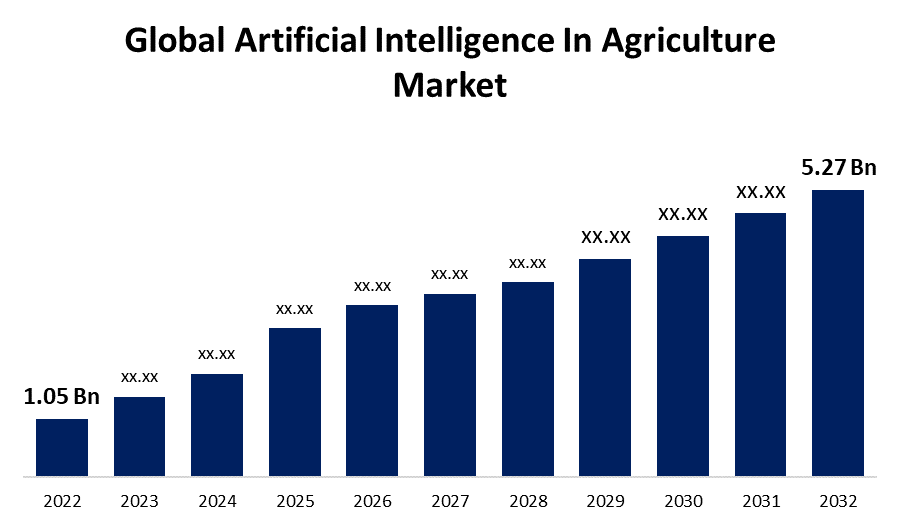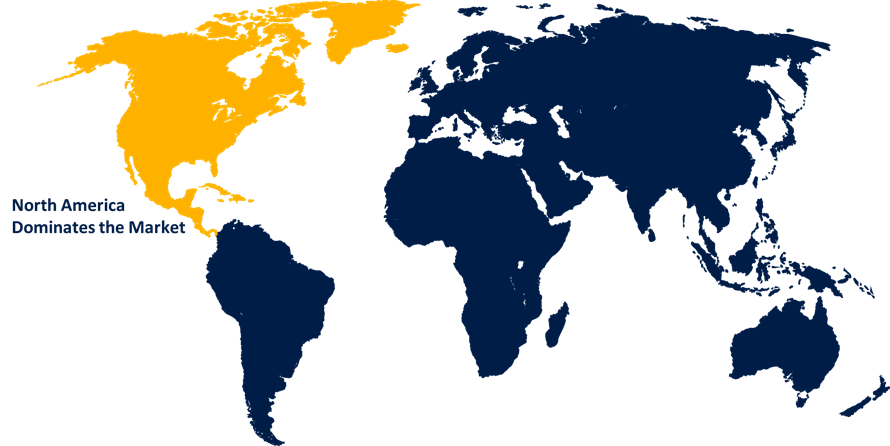Global Artificial Intelligence In Agriculture Market Size, Share, and COVID-19 Impact Analysis, By Technology (Machine Learning, Computer Vision, and Predictive Analytics), By Offering (Hardware, Software, AI-as-a-Service, and Service), By Application (Precision Farming, Agriculture Robots, Livestock Monitoring, Drone Analytics, Labor Management, and Others), By Region (North America, Europe, Asia-Pacific, Latin America, Middle East, and Africa), Analysis and Forecast 2022 - 2032
Industry: Information & TechnologyGlobal Artificial Intelligence In Agriculture Market Insights Forecasts to 2032
- The Global Artificial Intelligence in Agriculture Market Size was valued at USD 1.05 Billion in 2022.
- The Market is Growing at a CAGR of 17.5% from 2022 to 2032
- The Worldwide Artificial Intelligence in Agriculture Market Size is expected to reach USD 5.27 Billion by 2032
- Asia-Pacific is expected to grow the fastest during the forecast period

Get more details on this report -
The Global Artificial Intelligence in Agriculture Market Size is expected to reach USD 5.27 Billion by 2032, at a CAGR of 17.5% during the forecast period 2022 to 2032.
Market Overview
Artificial Intelligence (AI) is revolutionizing the agriculture industry by improving efficiency, sustainability, and productivity. AI in agriculture encompasses various technologies like machine learning, computer vision, and robotics. These technologies enable farmers to make data-driven decisions and optimize their operations. AI helps in crop monitoring, disease detection, and yield prediction by analyzing satellite imagery, weather patterns, and sensor data. It assists in precision farming by delivering targeted interventions, such as optimized irrigation and pesticide usage, reducing costs and environmental impact. AI-powered robots and drones automate labor-intensive tasks like planting, harvesting, and weed control. Furthermore, AI-enabled systems facilitate farm management, supply chain optimization, and market forecasting, empowering farmers to maximize yields and profits. As AI continues to advance, its integration with agriculture holds immense potential for sustainable and efficient food production.
Report Coverage
This research report categorizes the market for artificial intelligence in agriculture market based on various segments and regions and forecasts revenue growth and analyzes trends in each submarket. The report analyses the key growth drivers, opportunities, and challenges influencing the artificial intelligence in agriculture market. Recent market developments and competitive strategies such as expansion, product launch, and development, partnership, merger, and acquisition have been included to draw the competitive landscape in the market. The report strategically identifies and profiles the key market players and analyses their core competencies in each sub-segments of the artificial intelligence in agriculture market.
Global Artificial Intelligence In Agriculture Market Report Coverage
| Report Coverage | Details |
|---|---|
| Base Year: | 2022 |
| Market Size in 2022: | USD 1.05 Billion |
| Forecast Period: | 2022-2032 |
| Forecast Period CAGR 2022-2032 : | 17.5% |
| 2032 Value Projection: | USD 5.27 Billion |
| Historical Data for: | 2018-2021 |
| No. of Pages: | 200 |
| Tables, Charts & Figures: | 120 |
| Segments covered: | By Technology, By Offering, By Application, By Region. |
| Companies covered:: | Deere & Company, IBM Corporation, Microsoft Corporation, Google LLC, The Climate Corporation, Farmers Edge Inc., Granular Inc., AgEagle Aerial Systems Inc., Descartes Labs, Inc., Raven Industries Inc., AGCO Corporation, Gamaya SA, Bayer AG. |
| Pitfalls & Challenges: | COVID-19 Empact, Challenge, Future, Growth, & Analysis |
Get more details on this report -
Driving Factors
The rapid growth of artificial intelligence in the agriculture market can be attributed to several key drivers. The increasing global population and the subsequent need to meet rising food demand are putting immense pressure on the agriculture industry to enhance productivity and efficiency. AI offers advanced analytics and predictive modeling capabilities, enabling farmers to optimize crop yields and reduce losses. The availability of large volumes of agricultural data, including weather patterns, soil conditions, and plant health, has paved the way for AI-driven insights and decision-making. Moreover, advancements in technologies like machine learning, computer vision, and robotics have made AI solutions more accessible and cost-effective for farmers. Furthermore, government initiatives and support, coupled with the growing awareness of sustainable farming practices, are encouraging the adoption of AI in agriculture. Overall, these drivers are fueling the widespread adoption of AI, transforming the agriculture industry into a more data-driven and efficient sector.
Restraining Factors
Artificial intelligence in the agriculture market faces certain restraints that hinder its growth and adoption. The high initial cost of implementing AI technologies and infrastructure can be a significant barrier, especially for small-scale farmers or those in developing regions with limited financial resources. The lack of skilled workforce proficient in AI and data analytics poses a challenge in effectively utilizing AI tools and extracting meaningful insights from agricultural data. Additionally, concerns around data privacy and security can limit the willingness of farmers to share their data with AI systems. Lastly, the complexity of integrating AI technologies into existing farming practices and the potential resistance to change within the agricultural community can impede the widespread adoption of AI in Agriculture.
Market Segmentation
- In 2022, the machine learning segment accounted for around 35.6% market share
On the basis of technology, the global artificial intelligence in agriculture market is segmented into machine learning, computer vision, and predictive analytics. The machine learning segment has emerged as the leader in the artificial intelligence in agriculture market, holding the largest market share. This can be attributed to several factors. Machine learning algorithms enable farmers to analyze large volumes of agricultural data and extract valuable insights to make informed decisions. These algorithms can process complex patterns and trends, leading to improved crop monitoring, disease detection, and yield prediction. Machine learning models also facilitate precision agriculture techniques, optimizing resource allocation and reducing waste. Additionally, machine learning algorithms empower AI-powered robots and drones to perform tasks like planting, harvesting, and weed control with high accuracy and efficiency. The versatility and effectiveness of machine learning in addressing various agricultural challenges make it the dominant segment in the AI in agriculture market.
- In 2022, the software segment dominated with more than 32.5% market share
Based on the type of offering, the global artificial intelligence in agriculture market is segmented into hardware, software, AI-as-a-service, and service. The software segment has emerged as the leader in the artificial intelligence in agriculture market, holding the largest market share. This can be attributed to several factors. AI software plays a crucial role in enabling data processing, analytics, and decision-making in agriculture. It provides the foundation for implementing AI algorithms and models, allowing farmers to leverage the power of AI in their operations. AI software solutions offer a wide range of functionalities, including crop monitoring, disease detection, yield prediction, and farm management. These software tools empower farmers to optimize their farming practices, improve efficiency, and maximize yields. Moreover, the availability of user-friendly and customizable software platforms has made it easier for farmers to adopt AI in agriculture. The dominance of the software segment underscores the critical role of AI software in driving the transformation of the agriculture industry.
Regional Segment Analysis of the Artificial Intelligence In Agriculture Market
- North America (U.S., Canada, Mexico)
- Europe (Germany, France, U.K., Italy, Spain, Rest of Europe)
- Asia-Pacific (China, Japan, India, Rest of APAC)
- South America (Brazil and the Rest of South America)
- The Middle East and Africa (UAE, South Africa, Rest of MEA)
North America dominated the market with more than 52.4% revenue share in 2022.

Get more details on this report -
Based on region, North America has emerged as a dominant player in artificial intelligence in the agriculture market, holding the largest market share. Several factors contribute to this leadership position. North America is home to technologically advanced countries like the United States and Canada, which have a strong focus on agricultural innovation. These nations have well-developed infrastructure, access to advanced AI technologies, and a supportive regulatory environment, which fosters the adoption of AI in agriculture. There is a significant concentration of key market players and research institutions in North America, driving innovation and collaboration in the field. Additionally, the region has a large agricultural sector that faces challenges such as labor shortages and sustainability concerns, making it ripe for AI-driven solutions. These factors have propelled North America to the forefront of the AI in Agriculture market, capturing the largest market share.
Recent Developments
- In May 2022, AGRA and Microsoft have announced an extension of their collaboration to enhance the digital transformation of agriculture in Africa, with the goal of enhancing food security. This partnership aims to provide support to governments, farmers, and SMEs in the region, enabling them to develop robust food systems by leveraging the digital tools offered by Microsoft.
Competitive Analysis:
The report offers the appropriate analysis of the key organizations/companies involved within the global artificial intelligence in agriculture market along with a comparative evaluation primarily based on their product offering, business overviews, geographic presence, enterprise strategies, segment market share, and SWOT analysis. The report also provides an elaborative analysis focusing on the current news and developments of the companies, which includes product development, innovations, joint ventures, partnerships, mergers & acquisitions, strategic alliances, and others. This allows for the evaluation of the overall competition within the market.
List of Companies:
- Deere & Company
- IBM Corporation
- Microsoft Corporation
- Google LLC
- The Climate Corporation
- Farmers Edge Inc.
- Granular Inc.
- AgEagle Aerial Systems Inc.
- Descartes Labs, Inc.
- Raven Industries Inc.
- AGCO Corporation
- Gamaya SA
- Bayer AG
Key Target Audience
- Market Players
- Investors
- End-Users
- Government Authorities
- Consulting and Research Firm
- Venture Capitalists
- Value-Added Resellers (VARs)
Market Segment
This study forecasts revenue at global, regional, and country levels from 2019 to 2032. Spherical Insights has segmented the global artificial intelligence in agriculture market based on the below-mentioned segments:
Artificial Intelligence In Agriculture Market, By Technology
- Machine Learning
- Computer Vision
- Predictive Analytics
Artificial Intelligence In Agriculture Market, By Offering
- Hardware
- Software
- AI-as-a-Service
- Service
Artificial Intelligence In Agriculture Market, By Application
- Precision Farming
- Agriculture Robots
- Livestock Monitoring
- Drone Analytics
- Labor Management
- Others
Artificial Intelligence In Agriculture Market, Regional Analysis
- North America
- US
- Canada
- Mexico
- Europe
- Germany
- UK
- France
- Italy
- Spain
- Russia
- Rest of Europe
- Asia Pacific
- China
- Japan
- India
- South Korea
- Australia
- Rest of Asia Pacific
- South America
- Brazil
- Argentina
- Rest of South America
- Middle East & Africa
- UAE
- Saudi Arabia
- Qatar
- South Africa
- Rest of Middle East & Africa
Need help to buy this report?